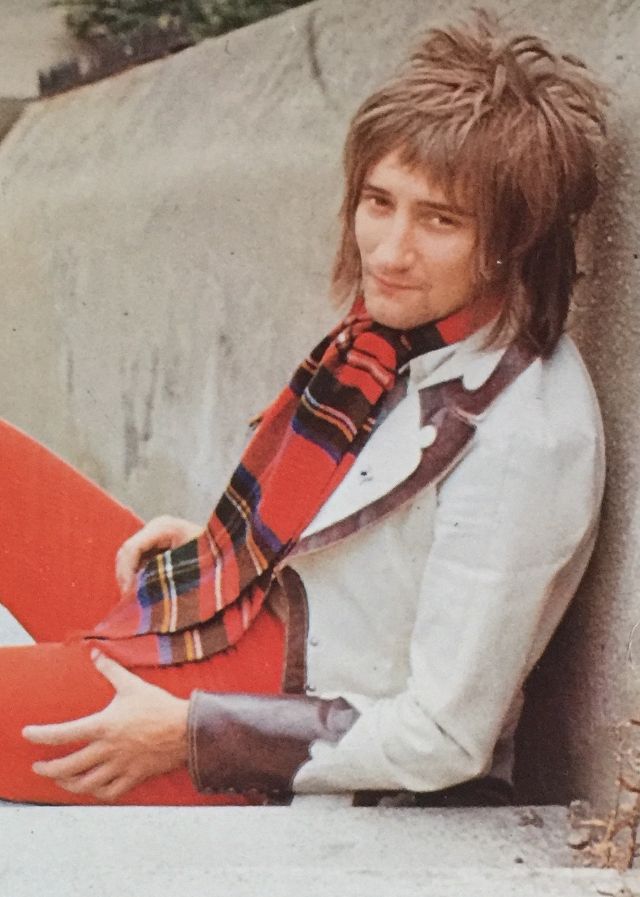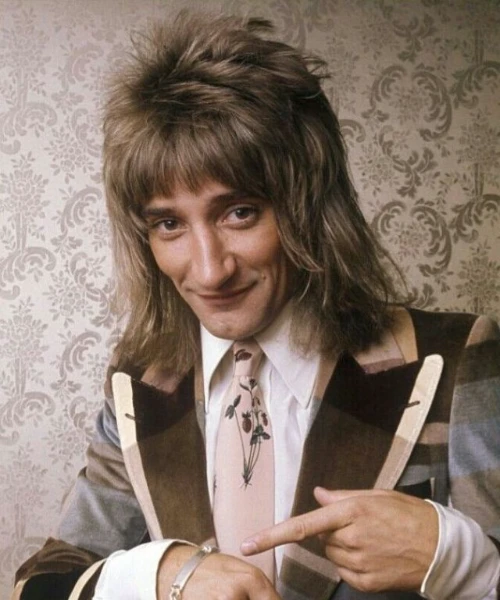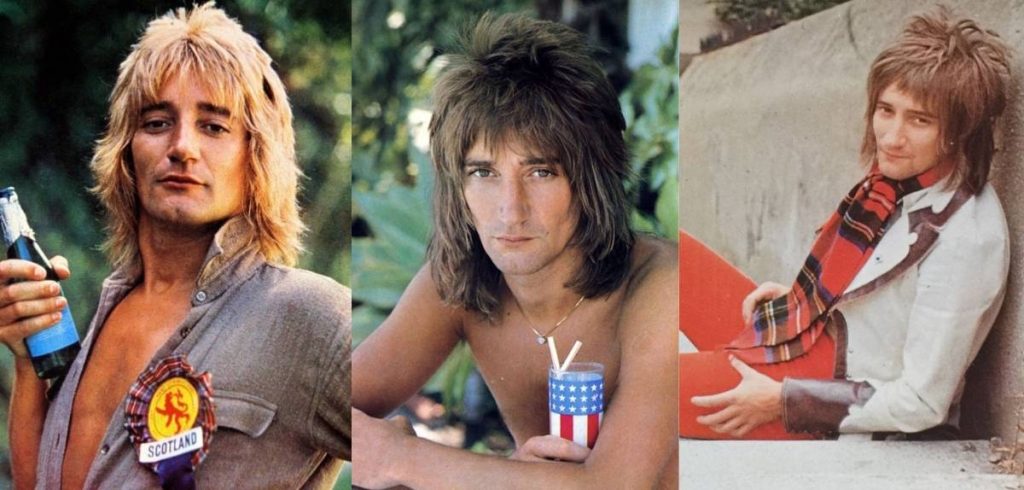Rod Stewart’s hair wasn’t just part of his look—it was his look. That untamed, feathered mullet became one of the most recognizable hairstyles in music history, symbolizing pure rock ’n’ roll rebellion. “Every Picture Tells a Story,” he once sang—and his hair told the story of confidence, swagger, and timeless cool.
From smoky London clubs to packed stadiums, Stewart’s wild mane defined a generation. It wasn’t overly styled or tamed—it was free-spirited, much like his voice and energy. This guide dives deep into the origins, evolution, and lasting influence of the Rod Stewart mullet, plus how to recreate it for the modern day without looking stuck in the ’70s.
The Origins of Rod Stewart’s Mullet

Early Influences: The 1960s Shag
Before the mullet made its debut, Rod Stewart sported a classic mod-inspired shag—a look born out of the British Invasion scene. As the frontman for The Faces, his hair reflected the rebellious youth of the time: tousled, messy, and effortlessly cool. Think Mick Jagger meets a London street poet.
By the late ’60s, Stewart began growing his hair longer at the back, blending the mod look with a touch of bohemian flair. This shift wasn’t random—it mirrored the evolving sound of British rock, moving from polished pop to raw, soulful energy.
The Breakthrough Era: Birth of the Mullet (Late 1960s–Early 1970s)
The early ’70s marked the birth of the Rod Stewart mullet. The style first appeared around his breakout album Every Picture Tells a Story (1971), where feathered layers framed his face while the back cascaded into longer, freer locks. It wasn’t about perfection—it was about personality.
In interviews, Stewart once joked that his hair “had a life of its own,” often styled on the go between gigs. That carefree, rockstar attitude turned his cut into an instant trademark.
The mullet’s message? Business in the front, party in the back—and Rod Stewart made it look like pure art.
Evolution of the Mullet Through the Decades
Rod Stewart’s mullet didn’t just define one moment—it evolved with him. Each decade brought subtle changes that reflected his music, mood, and the cultural tides of fashion. From the voluminous 1970s fluff to the softer, highlighted 1980s curls, his hair told the story of a man who could reinvent himself while keeping that unmistakable rock edge.
The 1970s: The Golden Age of the Stewart Mullet

In the ’70s, Stewart’s mullet was pure perfection—wild yet polished. The feathered layers and natural volume created his signature halo effect, especially during the A Night on the Town era (1976). It was the kind of hair that moved as much as he did on stage, bouncing under concert lights and commanding attention from every angle.
Fans and fellow musicians admired the way he wore his hair as a badge of freedom. Photographer Terry O’Neill once described his look as “uncontrolled energy in motion,” a fitting reflection of Stewart’s rise as both a solo artist and fashion icon.
The 1980s: Mullet Goes Mainstream
By the 1980s, Stewart’s mullet took on a more refined shape. The curls got tighter, the highlights brighter, and the overall look felt more MTV-ready. During his Out of Order tour (1988), the haircut became cleaner, with less volume but more gloss—proof that the mullet could grow up without losing its spark.
This decade also saw Stewart experimenting with color, adding golden tones that complemented his sun-kissed stage persona. It was softer but still unmistakably “Rod.”
The 1990s: Rock Royalty with a Mature Edge
The Vagabond Heart era (1991) marked a turning point. The mullet had shortened, the sides were neater, and the texture became more natural. It reflected his evolution from rock rebel to polished performer. During his Grammy appearances, Stewart’s hair still carried that signature lift at the crown—but it now whispered class instead of shouting chaos.
The 2000s–2010s: The Legacy Lives On
As Stewart transitioned into his Great American Songbook phase, his hair followed suit—thinning slightly, but still styled with flair. The mullet wasn’t gone; it had matured, mirroring his timeless voice and effortless charisma. Even during his Las Vegas residencies, that familiar shape lingered, reminding fans that some legends never fully change.
The 2020s: A Modern Revival
In recent years, the mullet has made a comeback, and Stewart’s influence is clear. From TikTok stylists to red-carpet revivals, the “Rod Stewart-inspired mullet” has become shorthand for fearless individuality. Stewart himself occasionally nods to his roots, wearing a looser, textured version during his 2023 Rock Hall performance—a wink to the past with a modern twist.
How to Get the Rod Stewart Mullet: Step-by-Step Guide
Rod Stewart’s mullet might look like it happened by accident—but there’s serious method behind that glorious mess. It’s all about balance: volume at the top, softness at the back, and just enough movement to make it look alive. Whether you’re going for a full retro revival or a toned-down modern version, here’s how to get the look right.
Tools You’ll Need
- Round brush: To lift the roots and shape the layers.
- Volumizing mousse or spray: Adds that signature lift without stiffness.
- Hairdryer with diffuser: Essential for creating Stewart’s windswept texture.
- Medium-hold hairspray: Keeps the volume locked in place while staying touchable.
- Texturizing shears (for barbers): To feather the ends and avoid blunt lines.
Step-by-Step Instructions
- Section the Hair:
Start with damp hair. Divide it into three sections—top, sides, and back. The top and sides should stay around 2–3 inches in length, while the back grows out to shoulder length. - Layer and Feather:
Use texturizing scissors to add soft, feathered layers throughout. The goal is flow, not structure—every strand should blend seamlessly into the next. - Blow-Dry for Lift:
Apply volumizing mousse to the roots. Blow-dry with your round brush, pulling upward at the crown to get that classic Stewart “lift.” - Add Texture:
Use your fingers or a diffuser to create slight bends and movement. Stewart’s mullet wasn’t poker-straight—it had natural body and direction. - Set with Hairspray:
Finish by teasing the crown lightly, then mist hairspray for hold. You want bounce, not crunch.
Pro Styling Tips
- For a modern twist: Keep the sides tighter and the back slightly shorter for a more wearable, 2020s-ready mullet.
- For curly hair: Use a curl-enhancing cream instead of mousse for softer definition.
- Avoid over-layering: Too many short layers will lose that vintage rockstar balance.
- Maintenance: Trim every 6–8 weeks to keep the shape fresh but lived-in.
Celebrity Stylist Insight
According to stylist Sam McKnight (who’s worked with Stewart himself), “Rod’s hair was all about controlled chaos—big, bold, but never overdone. The trick is teasing just enough volume to look natural.” Source: British Vogue.
Cultural Impact and Legacy
Rod Stewart’s mullet wasn’t just a haircut—it was a cultural statement. It symbolized freedom, fun, and rebellion, capturing the spirit of rock ’n’ roll better than any album cover ever could. For decades, it inspired musicians, fashion designers, and fans who wanted to look just a little bit wild without going over the edge.
In Music and Fashion
Stewart’s style didn’t exist in a vacuum—it paved the way for an entire era of bold, untamed hair. Artists like David Bowie, Billy Idol, and later John Bon Jovi drew from that same “controlled chaos” aesthetic. The mullet became a rock essential: business in the front, full concert in the back.
His influence didn’t stop at the stage. Fashion followed suit, with glam-rock-inspired layers and feathered textures becoming staples of 1970s and 1980s style. Even today, designers like Gucci and Saint Laurent channel that retro edge in runway looks that echo Stewart’s signature silhouette.
Pop Culture Moments
From movie references in Wayne’s World to endless internet memes, Stewart’s haircut continues to be part of pop culture’s visual language. Rolling Stone and VH1 have both included his mullet in their “Best Rock Hair of All Time” lists, cementing its status as one of music’s most recognizable styles.
In Almost Famous (2000), the rock-inspired wardrobe and hair were directly influenced by Stewart’s 1970s look—proof that his presence shaped not only sound but style.
Modern Revivals
Fast forward to the 2020s, and the mullet is having a full-blown renaissance. Celebrities like Billie Eilish, Timothée Chalamet, and Miley Cyrus have all embraced versions of the look, modernizing it with sleeker lines and pastel tones. Stewart’s influence lives on every time a new artist leans into that mix of polish and playfulness.
Even Stewart himself has acknowledged the trend’s return. In a BBC interview, he laughed, “I guess I was just ahead of my time—again.” His words ring true: while trends come and go, the Rod Stewart mullet never really disappeared—it just evolved with the world.
Fun Facts
- Rumor has it Stewart once insured his hair for thousands of pounds during the height of his fame.
- At tribute concerts, fans often arrive wearing DIY feathered wigs in homage to his legendary locks.
- On TikTok, the hashtag #RodStewartHair has millions of views, proving his style legacy spans generations.
Conclusion
Rod Stewart’s mullet wasn’t just a look—it was an attitude. It captured everything the singer stood for: charisma, confidence, and a dash of mischief. Across five decades, his hair evolved with him but never lost that signature flair that screamed, “I’m here to have a good time.”
What makes it timeless is its balance between effort and ease. It looked wild but never messy, styled but never stiff. Whether on stage in the ’70s or walking red carpets in the 2020s, Stewart proved that true style doesn’t fade—it adapts.
So if you’re tempted to try the look yourself, go for it. Embrace the layers, tease a little volume, and remember the spirit behind it. As Rod himself once said, “Hair’s just hair, but mine’s legendary.”
Feeling inspired? Rock your own mullet and share your look with #RodMullet—because every era deserves a little bit of that Stewart swagger.

